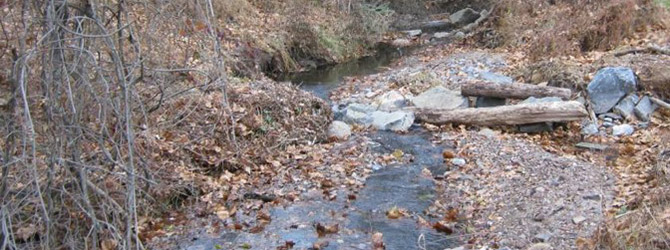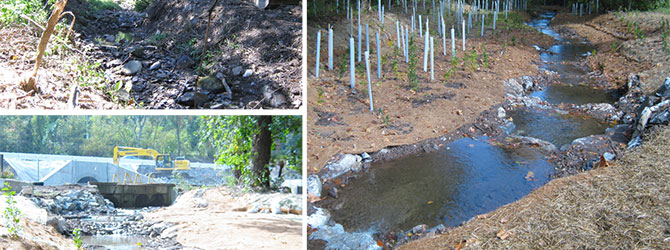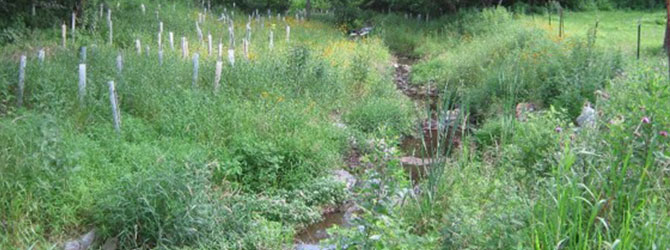The Environmental Protection Agency (EPA) protects water quality by regulating municipal separate storm sewer systems (MS4s) to reduce the pollutants that stormwater carries into storm sewers. Pollutants such as oil, pesticides, and sediments are picked up by stormwater and carried through storm sewers into waterways. Increased stormwater runoff volumes can also result in increased receiving channel erosion and sediment loading. MS4s meet permit and total maximum daily load (TMDL) requirements through a suite of strategies including educating the public, eliminating illicit discharges, and controlling runoff from construction sites and existing impervious areas. When a single strategy is not effective, a treatment train approach can do the trick.
Enter Natural Stream Channel Restoration
When combined with other measures such as street inlet cleaning, illicit discharge elimination, and stormwater basins constructed to filter pollutants, stream restoration can be used at the end of the treatment train in combination with other stormwater control measures (SCMs) to dramatically reduce pollutant loads in our waterways. When we restore the natural state and functioning of a degraded stream or river, we reduce bed and bank erosion and capture pollutants (sediment and nutrients) before they are transported downstream.
Natural stream channel restoration is careful business, requiring thorough geomorphic assessment, natural channel design, wet channel conveyance (step-pool conveyance), legacy sediment removal, floodprone area reconnection, and other streambed and bank modifications to restore natural forms, functions, and processes.
 Prior existing unstable, eroded, and incised channel condition with disconnected floodplain.
Prior existing unstable, eroded, and incised channel condition with disconnected floodplain.
To identify suitable stream restoration locations and develop appropriate concept designs, planners, scientists, and engineers evaluate and complete an inventory of opportunities and constraints, including:
- Determination of prior/historical alteration(s) resulting in current impaired stream conditions;
- Accessibility (ownership, easements, rights of way);
- Existing adjacent infrastructure (including roads, bridges, sewer, pipelines, public facilities, trails, parks, greenways);
- Environmental constraints (waste sites and sensitive wetlands, habitat, historical and archaeological resources);
- Stormwater floodplain retention and reconnection opportunities; and
- Existing bed and bank channel erosion, incision, and impairments that when restored net the greatest credit for the cost of the proposed restoration.
 Impaired channel during restoration, shortly after construction.
Impaired channel during restoration, shortly after construction.
Winning the Cost vs. Benefit Analysis
The cost benefit analysis for such projects may involve screening multiple sites and studying conceptual alternatives. Stream restoration projects constructed as part of a proper treatment train will maintain themselves, so future maintenance costs are reduced and potentially eliminated. Frequently stream restoration projects can be combined with improvements to public parks and greenways, giving increased weight to the benefit side of the equation.
Headwater streams (first-, second-, and third-order streams) that have been filled, drained, channelized, or encroached upon, can offer the greatest potential pollutant reduction opportunities through restoration and floodplain reconnection. Stream restoration is most effective when it supports the reconnection of floodplains and establishment of the vegetative riparian buffer—which promote sedimentation and nutrient uptake and removal within the functioning storm/floodplain or bankfull discharge floodprone area, while reducing bank shear stress.
When properly assessed, designed, jointly implemented, and constructed, natural channel stream restoration can provide the greatest opportunity for pollutant reduction removal at reduced maintenance costs. Benefits typically far exceed cost, especially when accounting for the triple bottom line of social, economic, and ecologic benefits.
And, after restoring trout streams, they fish great!
 Restored green vegetated stable channel and reconnected floodplain one year after restoration.
Restored green vegetated stable channel and reconnected floodplain one year after restoration.